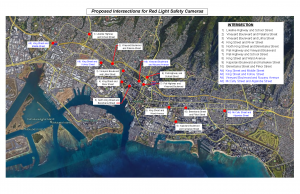Red-Light Safety Program Pilot begins with engineering studies at 10 Honolulu intersections
Posted on Feb 1, 2022 in Highways News, Main, NewsHONOLULU – The Hawaii Department of Transportation (HDOT) announces the initiation of engineering studies to select the intersections for the two-year pilot authorized by Act 30 (20). The goal of red-light safety cameras is to reduce lives lost in motor vehicle crashes by deterring red-light running.
The pilot project will begin with engineering studies at potential locations to determine whether installation of red-light cameras is feasible and can increase safety. HDOT worked with the City & County of Honolulu’s Department of Transportation Services to select the potential intersections based on crash history and site suitability.
The engineering studies to select the ten intersections for the pilot began in January and are expected to be completed in March. The studies will identify conditions that may contribute to red-light running violations and appropriate countermeasures. As the studies are completed, they will be posted to the HDOT website at https://hidot.hawaii.gov/highways/red-light-safety-program/
Once selection of the ten pilot locations is finalized, next steps will include installation of signage giving notice of the presence of automated enforcement, installation of the camera systems, training of personnel to review images captured by the systems, and issuance of warnings. Information on requirements for the engineering studies, content and retention of images, and vendor compensation is available in the text of the Hawaii Administrative Rule 19-151 at https://hidot.hawaii.gov/highways/files/2022/01/Chapter-19-151.pdf
Redflex Traffic Safety Systems, now owned by and operating as Verra Mobility, has been awarded the contract to install and support the red-light running pilot in Honolulu.
“Running red lights is a major contributing factor to urban crashes nationwide,” said Hawaii Department of Transportation Deputy Director for Highways Ed Sniffen. “Our goal for the two-year pilot is to make our streets safer by changing driver behavior.”
###

